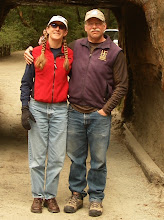The site had many temples and had a renaissance during the Roman period (approx. 100 to 400 A.D.) during which a large hotel for visitors was built. The site was abandoned by order of Theodisus I, then destroyed by two earthquakes, then covered over by 18 ft. of silt from the adjacent river flooding. The following picture shows the columns from the Temple of Zeus as they lay.
Some of the areas have been resurrected and give you an idea about how beautiful the site was.
When the archaeologists excavated, they found many of the treasures well preserved including the famous Hermes by Praxilites.
Several other artifacts caught our eye as well.
The large bronze lion head below is a piece of hammered bronze from a single plate of bronze.
An other thing about the ancient games is that they had a problem with cheating, just like these days, enough so that they devised systematic method of dealing with it. The cheater was fined and the fines went to paying for a bronze bust of Zeus beneath which the cheater's name was inscribed. These busts with cheaters names lined the approach to the stadium, a walk of infamy if you will.
Tomorrow we approach the port to ferry to Kephallonia.

2 comments:
Following your blog makes me feel like a "remote access tourist" but that designation has morphed into "remote access student" as you bring history to life with your notes and pics. Thanks!
Diana, you hit the nail on the head. We are trying to make the blog diverse with foodie info., bicycling challenges, people, and local culture/history. Glad you are enjoying!
Post a Comment